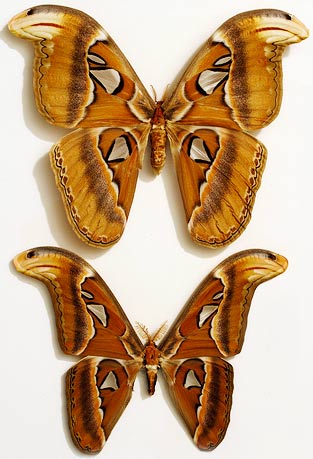Atlas Moth – World’s Largest Moth Never Eats

It is not entirely certain where the atlas gets its name from: it could be from its huge size, with reference to atlas of Greek mythology, or it could refer to the patterns on its wings, which resemble maps in an atlas. In Hong Kong, the Cantonese name for it is “snake’s head moth”. This refers to the snake-like shape of the pattern on the top wing tips.
Largest Species of Moth
Atlas moths are the largest species of moth in the world. The females have bigger, heavier bodies than males and larger wingspans too, ranging from 25 to 30 cm (10 to 12 inches), with a surface area of at least 400 cm² (62 sq in). Despite their huge size, the moths do not eat anything once they hatch from their cocoons. Both males and females lack fully-formed mouth parts; they rely on the sustenance they build up as caterpillars, for stored energy. They only live as hatched moths for two to three weeks.

The natural habitat of the atlas moth, is Southeast Asia, particularly around the Malay archipelago. They do not fly far from where they hatch, since they are very inelegant fliers and do not have enough energy stored for long journeys. They live purely to breed, so the fact that they do not venture far from their hatching area, allows for easy mating to occur.

There are some species of moth with longer wings, but the atlas moth has, on average, the largest wingspan in terms of area. These moths belong to the Satuniidae family. Other moths that belong to that family, include another impressive specimen – the luna moth.
The Atlas Moth Caterpillar
The atlas moth caterpillar has to eat a huge amount of food, to store enough fat for life as an adult moth. They eat citrus, willow leaves, and evergreen tree leaves. In India, the silk from the caterpillars is not farmed commercially, but the characteristic brown silk is used in a small-scale capacity. It is known as fagara, and is more durable than regular silkworm moth silk. The cocoons are sometimes used as purses or handbags in Taiwan.
The caterpillars hatch from small eggs that are laid on the underside of leaves. They hatch within two weeks and feed until they are about 115 mm (4.5 in), before pupating. The caterpillar has spines that are soft and fleshy, which protrude upwards from its back. They are coated with a white, waxy layer.
